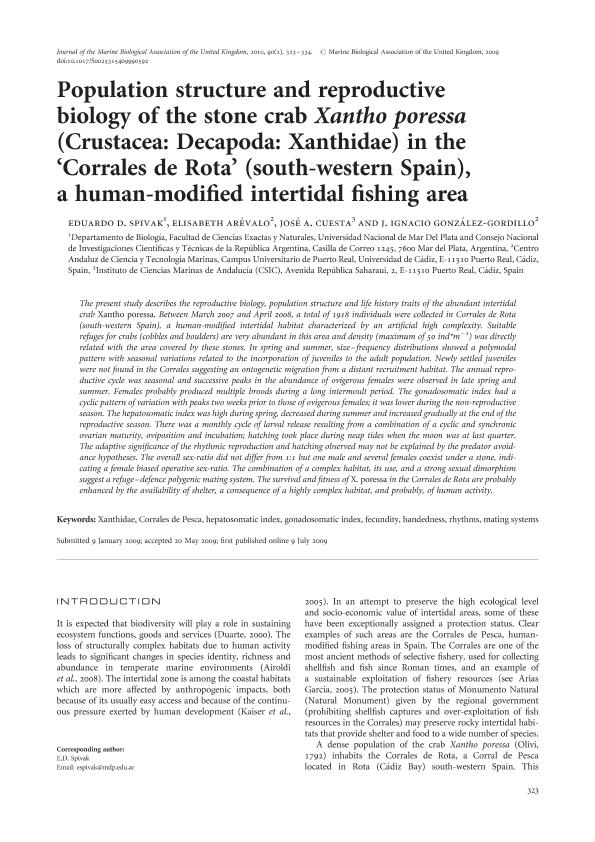Mostrar el registro sencillo del ítem
dc.contributor.author
Spivak, Eduardo Daniel

dc.contributor.author
Arévalo, Elisabeth
dc.contributor.author
Cuesta, José A.
dc.contributor.author
González Gordillo, J. Ignacio
dc.date.available
2020-01-30T17:55:13Z
dc.date.issued
2010-03
dc.identifier.citation
Spivak, Eduardo Daniel; Arévalo, Elisabeth; Cuesta, José A.; González Gordillo, J. Ignacio; Population structure and reproductive biology of the stone crab Xantho poressa (Crustacea: Decapoda: Xanthidae) in the 'Corrales de Rota' (south-western Spain), a human-modified intertidal fishing area; Cambridge University Press; Journal of the Marine Biological Association of the United Kingdom; 90; 2; 3-2010; 323-334
dc.identifier.issn
0025-3154
dc.identifier.uri
http://hdl.handle.net/11336/96236
dc.description.abstract
The present study describes the reproductive biology, population structure and life history traits of the abundant intertidal crab Xantho poressa. Between March 2007 and April 2008, a total of 1918 individuals were collected in Corrales de Rota (south-western Spain), a human-modified intertidal habitat characterized by an artificial high complexity. Suitable refuges for crabs (cobbles and boulders) are very abundant in this area and density (maximum of 50 ind*m−2) was directly related with the area covered by these stones. In spring and summer, size–frequency distributions showed a polymodal pattern with seasonal variations related to the incorporation of juveniles to the adult population. Newly settled juveniles were not found in the Corrales suggesting an ontogenetic migration from a distant recruitment habitat. The annual reproductive cycle was seasonal and successive peaks in the abundance of ovigerous females were observed in late spring and summer. Females probably produced multiple broods during a long intermoult period. The gonadosomatic index had a cyclic pattern of variation with peaks two weeks prior to those of ovigerous females; it was lower during the non-reproductive season. The hepatosomatic index was high during spring, decreased during summer and increased gradually at the end of the reproductive season. There was a monthly cycle of larval release resulting from a combination of a cyclic and synchronic ovarian maturity, oviposition and incubation; hatching took place during neap tides when the moon was at last quarter. The adaptive significance of the rhythmic reproduction and hatching observed may not be explained by the predator avoidance hypotheses. The overall sex-ratio did not differ from 1:1 but one male and several females coexist under a stone, indicating a female biased operative sex-ratio. The combination of a complex habitat, its use, and a strong sexual dimorphism suggest a refuge–defence polygenic mating system. The survival and fitness of X. poressa in the Corrales de Rota are probably enhanced by the availability of shelter, a consequence of a highly complex habitat, and probably, of human activity.
dc.format
application/pdf
dc.language.iso
eng
dc.publisher
Cambridge University Press

dc.rights
info:eu-repo/semantics/openAccess
dc.rights.uri
https://creativecommons.org/licenses/by-nc-sa/2.5/ar/
dc.subject
CORRALES DE PESCA
dc.subject
FECUNDITY
dc.subject
GONADOSOMATIC INDEX
dc.subject
HANDEDNESS
dc.subject
HEPATOSOMATIC INDEX
dc.subject
MATING SYSTEMS
dc.subject
RHYTHMS
dc.subject.classification
Biología Marina, Limnología

dc.subject.classification
Ciencias Biológicas

dc.subject.classification
CIENCIAS NATURALES Y EXACTAS

dc.title
Population structure and reproductive biology of the stone crab Xantho poressa (Crustacea: Decapoda: Xanthidae) in the 'Corrales de Rota' (south-western Spain), a human-modified intertidal fishing area
dc.type
info:eu-repo/semantics/article
dc.type
info:ar-repo/semantics/artículo
dc.type
info:eu-repo/semantics/publishedVersion
dc.date.updated
2020-01-28T15:01:41Z
dc.journal.volume
90
dc.journal.number
2
dc.journal.pagination
323-334
dc.journal.pais
Reino Unido

dc.journal.ciudad
Cambridge
dc.description.fil
Fil: Spivak, Eduardo Daniel. Consejo Nacional de Investigaciones Científicas y Técnicas; Argentina. Universidad Nacional de Mar del Plata. Facultad de Ciencias Exactas y Naturales. Departamento de Biología; Argentina
dc.description.fil
Fil: Arévalo, Elisabeth. Universidad de Cádiz; España
dc.description.fil
Fil: Cuesta, José A.. Consejo Superior de Investigaciones Científicas; España
dc.description.fil
Fil: González Gordillo, J. Ignacio. Universidad de Cádiz; España
dc.journal.title
Journal of the Marine Biological Association of the United Kingdom

dc.relation.alternativeid
info:eu-repo/semantics/altIdentifier/url/https://www.cambridge.org/core/journals/journal-of-the-marine-biological-association-of-the-united-kingdom/article/population-structure-and-reproductive-biology-of-the-stone-crab-xantho-poressa-crustacea-decapoda-xanthidae-in-the-corrales-de-rota-southwestern-spain-a-humanmodified-intertidal-fishing-area/A4FAFD1BC8262121877D946E898ED2B4
dc.relation.alternativeid
info:eu-repo/semantics/altIdentifier/doi/https://doi.org/10.1017/S0025315409990592
Archivos asociados
